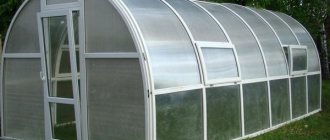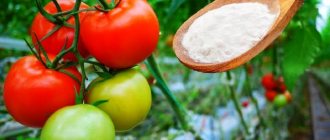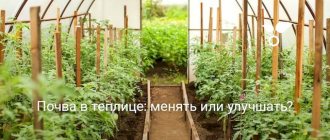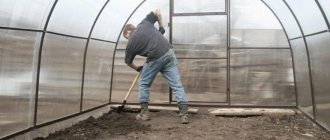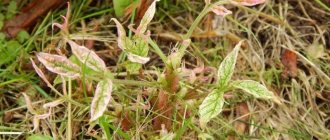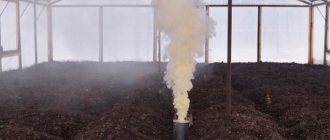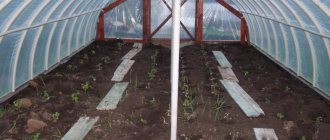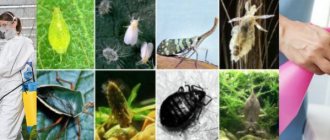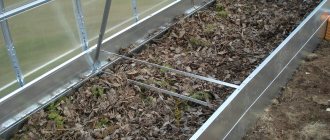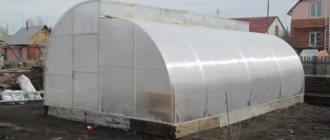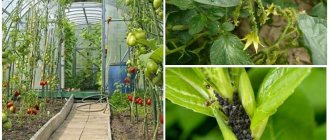The first thing you need to do to prepare your greenhouse for planting in the spring is to treat it against diseases and pests.
Dear readers!
For you, we have created communities on social networks in which useful articles and interesting ideas are published several times a day! Subscribe and receive useful content in a convenient format! If you follow a clear plan, the task becomes feasible. If preparations for the planting season have not yet been carried out, then it’s time to do so.
We will tell you in today’s article how exactly and with what to cultivate the land.
Why does a greenhouse need spring treatment?
It is necessary to treat the greenhouse in the spring against diseases and pests for the following reasons:
- Dirt accumulates on the walls and roof slopes, and harmful insects and microorganisms accumulate in the ground.
- High humidity creates favorable conditions for the development of putrefactive diseases.
- Pests like to “settle” here for the winter, laying larvae and pupae. Also, the soil requires periodic replenishment and sometimes replacement.
IMPORTANT! If you plant different crops in a greenhouse every year, the incidence of disease will significantly decrease
The greenhouse is prepared and disinfected regularly, even if there was no pest or disease invasion in the previous period.
How to treat a greenhouse against pests
Thorough treatment of the greenhouse against pests is carried out twice a year - in the fall after harvesting and in the spring before planting seedlings.
It is necessary to disinfect and treat not only the ground, but also the walls of the structure, where a sufficient number of parasites gather.
After winter, fasteners or parts of glass and polycarbonate may suffer from temperature changes, frost and snow.
Basically, spring treatment of greenhouse walls includes cleaning the walls from dust and dirt , as well as destroying all parasites using smoke bombs .
Folk remedies for soil treatment in a greenhouse in spring
If chemical bactericides were not purchased, traditional methods will come to the rescue.
Pine decoction
You can treat the soil in a greenhouse in the spring against diseases and pests using a pine decoction.
Needles (2 kg) or pine branches are compacted to half a bucket, filled with water, and left for about a week. Effective against pests.
Tobacco dust
The dust is prepared from waste tobacco products. Used to combat fleas, thrips, aphids, midges, spider mites and as a fertilizer.
Dust is added during digging at the rate of 3-4 grams per 1 sq.m. Before planting seedlings, the powder is poured into the holes.
Ash from diseases and pests
Ash contains potassium and phosphorus and neutralizes acidity. Ash is also covered when digging up soil in a greenhouse. It protects against diseases and insects (onion flies, aphids, powdery mildew).
Garlic for diseases
To treat the greenhouse, prepare a garlic infusion: chop 40 grams of garlic, add a bucket of water, leave for 24 hours.
Onion peel
A decoction of onion peels repels aphids, spider mites, flea beetles, thrips and moths. The decoction can be prepared as follows: pour 2 large handfuls of husks into 10 liters of water, boil for 5 minutes and leave for 4 hours. To prevent the appearance of harmful insects, onion peels are scattered around the perimeter of the greenhouse.
Traditional methods are available, but are still more suitable for preventing infections.
Planting material
It is very important to plant healthy seedlings in the greenhouse or sow seeds that are not infected with diseases. Even the best soil, capable of resisting pathogens, can suddenly contain so many pathogens that it cannot cope. Therefore, you should not test the disinfecting properties of soil.
To treat the seeds, it is enough to soak them in a weak solution of potassium permanganate or a soap suspension (the soap should be laundry soap). Then the seed should be rinsed and dried. It is recommended to sow seeds for seedlings in a high-quality mixture.
Soak the seeds in potassium permanganate to disinfect
Important! Contrary to popular belief, most soil mixtures offered by specialty stores are safe from the point of view of contamination by harmful microbes and eggs of pests.
You can make planting mixtures yourself by preparing leaf, turf, coniferous soil and sand in advance. All ingredients of the future substrate are well frozen in winter. If you have doubts about the quality, you can heat small amounts of soil in the oven.
Land for seedlings
Thus, creating a healthy microclimate in a greenhouse and growing strong and healthy plants is quite possible.
The conditions necessary for this will be created by:
How to treat a greenhouse against spider mites in the fall
Spider mites are a very dangerous, voracious pest that can easily destroy all your plants and ruin your harvest, as it spreads very quickly throughout the greenhouse. Read more about how to deal with it here.
Healthy soil and the same plants on it successfully resist the moderate onslaught of pathogens that are constantly present in the atmosphere and earth. Therefore, there is no need to worry about the harvest.
Effective preparations for cultivating soil in a greenhouse in spring
“Disinfectants” are divided into insecticides (destroy pests) and fungicides (destroy fungal spores).
Common insecticides include Inta-Vir, Aktara, and Iskra. Insecticides are diluted in water, and then they must be used to treat the walls, roof and ground of the greenhouse.
Before the procedure, the soil is moistened. Watering is carried out no later than 1 month before planting seedlings.
Farmayod
The bactericide gets rid of fungi, viruses, bacteria and harmful insects. It is used to water the surface and disinfect the structure. After this, the door is tightly closed and no one goes inside for 4 days.
Copper sulfate
Copper sulfate is effective against fungal spores, infections, and kills the larvae of harmful insects.
To treat with copper sulfate for preventive purposes, prepare a solution of low concentration - 75 grams per 10 liters of water. In the presence of pests and after diseases, take 150 grams per 10 liters. Bordeaux mixture, a mixture of vitriol and slaked lime, has a similar effect.
IMPORTANT! Copper is deposited and accumulates in the upper layers of the earth, increases acidity, and negatively affects productivity.
Fitolavin
The antibiotic protects the substrate and plants from rot, spots, and diseases. “Phytolavin” replaces toxic aggressive drugs at the onset of the disease and moderate infection.
The antibiotic accumulates in the fruits (in microdoses), so more than two procedures per season are not carried out.
Sulfur checkers
It is necessary to treat the greenhouse with a sulfur bomb in complex advanced cases. During the procedure, close the windows and close the door tightly. Place the checker on a non-flammable surface, set it on fire and immediately leave. For 10-20 cubic meters One 300 g checker is enough for the room.
You can enter in 2 days, plant plants in two weeks.
IMPORTANT! The checker spoils the structure (causes corrosion of metal coatings, clouding of polycarbonate, microcracks), destroys the beneficial microflora of the earth, and sulfur dioxide falls in the surface layer.
Pharmacy products
Many pathogens cannot tolerate hydrogen peroxide. To water, 1 tbsp of 3% peroxide is diluted with 1 liter of water.
You can prepare a solution of potassium permanganate: take 5 grams of crystals per 10 liters of water, stir well, treat the surface (about 50 ml per 1 sq.m.).
Cultures are planted 2 weeks after the procedure.
IMPORTANT! Many disinfectants are aggressive and toxic, so don’t forget protective equipment: respirator, gloves, goggles.
Chemical and biological methods of disinfection
If the plants were sick last season, then preventive measures must be carried out in the fall. However, it is not always possible to get rid of pathogens at one time, so repeated treatment in the spring will also come in handy.
- Bleaching powder . This chemical disinfection method is suitable for destroying pathogens of bacterial diseases, as well as pathogenic fungi. To prepare the solution, dilute 400 g of bleach in 10 liters of water, mix the solution thoroughly and let it brew for 4 hours. Pour the liquid into a spray bottle (no sediment!) and spray all surfaces of the building, close the greenhouse and leave for a couple of days. Then ventilate thoroughly.
- Copper sulfate . It is an inorganic, highly active fungicide with antiseptic properties. Protects against scab, gray rot, downy mildew, rust and late blight. The effect of the substance begins 1-3 hours after preparing the solution and ends after 14 days. After two weeks, the greenhouse needs to be ventilated.
If the crops in the greenhouse did not get sick last season, take 50-75 g of copper sulfate per 10 liters of water. If disease outbreaks have occurred, double the dosage.
- Pine needle decoction . This composition will be appreciated by adherents of everything natural. Fill half a bucket of compacted pine branches with water and let it brew. If there is no time to infuse, boil for 20 minutes. This treatment helps fight late blight and other fungal infections.
There is an opinion that pine branches can be replaced with 200 g of pharmaceutical pine extract.
- Fumigation . This is a general disinfection procedure (disinfects both surfaces and soil) and an extreme measure, which is resorted to in case of serious fungal infection. For fumigation, cuttings of sulfur are used at the rate of 1 kg per 10 cubic meters of area. Pound the sulfur, mix it with an equal part of charcoal and spread the resulting mixture on metal baking sheets. Place the baking sheets themselves in deep basins and place them in the greenhouse. Set fire to the sulfur, quickly leave the greenhouse and close the entrance door and ventilation transoms. An alternative to fumigation can be the use of sulfur bombs at the rate of 500 g per 10 cubic meters. After sulfur disinfection, the greenhouse is opened after 5 days, and the ventilation process should last at least 2 weeks.
After igniting the sulfur, you need to act very quickly, because The gas released during the process is poisonous. Carry out all manipulations with sulfur wearing gloves, safety glasses and, if possible, a respirator.
What biological means of soil cultivation in a greenhouse can be used in the spring?
Biological agents saturate the surface layers of the soil in the greenhouse with useful microelements. Biological products include:
- Biofungicides
- EM drugs
- Green manure
Biofungicides are cultures of bacteria and beneficial fungi. They displace hostile crops and “help” the plant. The preparations are used in the spring after disinfection.
- Trichocin fights rot and fungus. Water the top layer of soil with the product and spray the plants. It improves the properties of fruit crops and eliminates “stress” from chemicals. Drugs of the same type include Trichoderma, Trichoplant, Glyokladin.
- Fitosporin-M is a universal drug; it is used to treat soil and structures. The product fights diseases and pests, as well as late blight. Drugs of this type include Alirin-B, Gamair.
- Biocomplex BTU is a complex supplement of beneficial bacteria, containing mushrooms, beneficial bacteria, and phytohormones.
EM preparations are effective microorganisms. The drugs in this category include “Shine”, “Baikal-M”, “Ekomik”, “Biospectr”.
EMs do not accumulate in plants; on the contrary, they improve their quality and saturate them with microelements.
Sowing green manure
Green manures are plants that help fight pests and diseases; saturate the surface with useful microelements.
Before planting seedlings in the greenhouse in the spring, you can sow mustard, calendula, phacelia, and radish. They are cut before flowering and partially buried in the top layer of soil.
Cruciferous plants (radishes, radishes) are not sown if there will be crops of this family planted in the greenhouse (then it is better to sow phacelia).
Why is soil tillage needed?
I never forget about the autumn and spring cultivation of greenhouse soil; I consider this an important and necessary agrotechnical measure. As far as I know, not all gardeners share the same opinion - and very wrongly. Spores of infectious agents, eggs and larvae of pests overwinter well in a greenhouse and are “inherited” to future plantings.
High-quality and consistent processing successfully prevents this:
- Prevention of late blight.
- Fighting fungus and mold.
- Minimizing the risk of fungal and bacterial infections.
- Destruction of remaining pests, their larvae and eggs.
- Timely autumn treatment of the greenhouse reduces the amount of work in the spring - all you have to do is complete preventive measures.
Another benefit of autumn-spring tillage is improving the fertile qualities of greenhouse soil. Due to the limited space, nitrogen, phosphorus, potassium, and microelements necessary for planting are quickly washed out of it. Ideally, after the season, the top layer of greenhouse substrate is removed and replaced with fresh, fertile and uninfected one. But complex cultivation of the land helps me resort to this labor-intensive procedure only once every five years. I act like this:
- I remove the top layer of earth - 10-15 cm.
- I dig up the remaining greenhouse soil, manually removing plant debris, eggs and pest larvae.
- I plant the space with green manure, then mow them, and incorporate useful greens into the soil.
- I disinfect fresh soil either with chemicals (potassium permanganate, Bordeaux mixture) or with biological preparations (Fitosporin, Siyanie), after which I scatter it evenly over the greenhouse ridge.
How to use heat treatment in a greenhouse?
Thermal disinfection - exposing pests to extreme temperatures.
Freezing is carried out as follows: the soil is collected in bags and placed in a warm place for two weeks. During this time, the organisms in it will “come to life.” Then the bags are taken outside and kept in the cold (the lower the temperature, the better).
Harmful organisms are destroyed under the influence of high temperatures. To do this, take hot water or treat the soil in the greenhouse with steam. Before the procedure, the beds are dug to the depth of a spade bayonet. Take boiling water, pour over the surface and immediately cover with a film that does not allow steam to pass through. Can be repeated in a week.
Disinfection with steam in the spring is carried out as follows: the soil is collected in bags and placed on a grid (sieve) over a vat of boiling water for about 1.5-2 hours.
After heat treatment, fertilizers can be applied.
Agricultural technology
The basis of agriculture, whether in a greenhouse or open ground, is crop rotation. Pests accumulate where crops of the same family are grown year after year. This also contributes to the creation of conditions for the flourishing of soil microorganisms (fungi), since the conditions necessary for the same plants persist for several years.
Important! A completely different matter is a change of cultures. If you plant different plants in a greenhouse every year (at least every 1-2 years), then the incidence of diseases in the soil and crops will noticeably decrease.
Crop rotation
For example, cucumbers love high humidity and temperature. The soil under them should not dry out. In such conditions, the mushroom mycelium develops well, and in a year or two it will be problematic to cope with it. And if next year you plant tomatoes in this greenhouse, then you will have to create completely different conditions for them: dry air, temperatures much lower than for cucumbers, frequent ventilation. This will not allow the development of either fungi or some soil microbes.
Conditions for growing tomatoes and cucumbers in a greenhouse
Important! From an agronomic point of view, it is better to build 2-4 small greenhouses on a site than one giant one. This will help increase productivity, and in itself the creation of individual conditions for each plant with the application of fertilizers according to needs is another excellent technique.
Dependence of the location of the greenhouse on the shade of shrubs
Another way to improve soil health is to reduce soil acidity. For the most part, our soils are highly acidic, which in itself is not bad - microbes do not live in acidic soil. But there are few nutrients in it, beneficial microorganisms also do not take root, which means that plants grow either weakened or overfed with fertilizers. Neither one nor the other contributes to prosperity, so the plants die, leaving an environment for the development of rot, which significantly worsens the composition of the substrate and increases the incidence of crop diseases.
Store-bought kit for testing soil acidity
Soil acidity scale
Acidophiles - plants of acidic soils
Basiphyla - plants of alkaline soils
Neutrophils – plants of neutral soils
The addition of long-acting natural supplements in reasonable quantities will help reduce acidity and thereby correct the situation with natural fertility, such as:
- chalk;
- dolomite flour;
- ash.
These natural fertilizers are applied in the spring, after the melt water has disappeared, and repeated no earlier than after 2 years.
Required soil acidity for various crops
Limestone (dolomite) flour
Prices for dolomite flour
dolomite flour
Mechanical methods of soil treatment in a greenhouse in spring
Mechanical methods include digging, removing the top layer and replacing it with a fertilized and enriched one, and mulching. Replacement - removing the surface layer of earth about 30 cm thick.
In early spring, many summer residents collect snow to moisten and saturate the soil (gives it looseness), and throw snow on the beds in the greenhouse.
Mulching enriches the soil: use tree bark, manure (rotted for 4 months), compost (prepared in advance in the fall), lime (looses clay structures), sawdust (rotted in compost).
Mulch attracts worms, which do a good job of loosening the beds.
Preparing a greenhouse for the new season without replacing the soil - 5 simple rules
Preparations for a new harvest of vegetables in the greenhouse must begin in the fall. This is done primarily for sanitary reasons. By the end of the season, numerous sources of plant diseases remain on the soil, metal frame structures, and working tools. A humid and warm environment, like no other, promotes the proliferation of various viruses, fungi, bacteria - sources of numerous diseases. It is their appearance that contributes to a decrease in yield and increases the time required for their treatment.
There are 5 basic rules of what you should pay attention to when preparing a garden under glass in the spring.
- First of all, cleaning up the remains of plant debris, including weeds;
- Treatment and disinfection of the inner surface of polycarbonate, metal structures, tools that were used when working with the earth;
- Throwing a thick layer of snow on the beds;
- Application of biological products with beneficial microorganisms and sowing of green manure to improve soil health;
- Prevention of possible diseases and pests.
How to treat the soil before planting seedlings?
Before planting seedlings, the soil in the greenhouse must be prepared and processed:
Preparation stages:
- Cleaning up last year's garbage, digging
- Disinfection (disinfection) is carried out using chemical or thermal methods
- Application of mineral fertilizers or organic matter (rotted manure, compost), mulching. If the soil in the greenhouse is acidic, they are treated with lime, dolomite flour, ash, sodium or calcium nitrate.
- Before planting plants, after applying fertilizers, maintain a period of 1 week-10 days.
Improving soil fertility
In addition to therapeutic procedures, preparing a greenhouse in the spring also cannot be done without preparing proper soil mixtures - a high-quality basis for the future harvest. After all, in order to promote normal growth and development of plants, the soil needs proper care, as well as a sufficient amount of minerals. In this section we will try to understand the features of greenhouse soils and their preparation.
High-quality soil significantly increases productivity
Features of an ideal greenhouse soil
Let us immediately make a reservation that soil for greenhouses, which would be suitable for absolutely all plants grown in them, simply does not exist in nature. The choice of greenhouse soil mixture depends on many factors:
- requirements of the crop being grown;
- time of year and the presence of additional heating;
- climatic features of the region;
- availability of necessary ingredients.
To ensure normal yields, the soil in the greenhouse must meet the following requirements:
- ability to ensure normal heat and air exchange;
- high-quality water saturation during irrigation, as well as the ability to transmit it when growing non-moisture-loving plants;
- absorption of necessary microelements in cases of its fertilization.
The best soil mixtures in terms of their physical properties are those in which the ratio of liquid, solid and gaseous fractions is 1:1:1.
Soil for greenhouses: components and their properties
Among the possible components of greenhouse soil are the following elements: turf, sand, peat, clay, as well as conifer bark, straw, sawdust and fallen leaves, green manure and fully prepared composts. In addition, organic agents in the form of pus, humus and bird droppings, as well as a full set of necessary mineral macro- and microelements, are added to the soil mixture.
Each of them has its own special purpose in creating optimal soil for growing plants. So, sand serves as a baking powder and insulation, and clay retains moisture well. Sawdust, leaves, straw, etc. maintain the desired volumetric mass, improve the water regime and release carbon dioxide, and the bark serves as an antiseptic. The introduction of these components perfectly replenishes the soil with organic matter.
Plants need a nutrient medium
Another supplier of organic fertilizers to soil mixtures is manure. In addition, it perfectly maintains the structure of the soil, and also saturates the plants with a full range of micro- and macroelements. Peat eliminates excess life-giving components, releases carbon dioxide and adds organic matter. And lime materials optimize acidity and improve soil structure.
The more components are used to create a mixture, the more the possibilities of proper nutrition, formation and development of plants improve. In addition, by qualitatively complementing each other, the elements of multicomponent soils also mutually neutralize negative manifestations.
So, if fertilizers are applied in excess of the norm, their excess will be absorbed by sawdust, bark or peat. In turn, bird droppings will enrich them with nitrogen, and sand resists oxidation.
Do-it-yourself preparation of soil components
In fact, preparing a greenhouse in the spring for harvest begins with the preparation of components for greenhouse soil. And their combination is carried out depending on where and what vegetables are planned to be grown. Let us consider here the features of preparing the main components for the production of soil mixtures: turf, humus and composts.
The harvesting of turf land is carried out in late spring or early summer in areas where perennial cereals and legumes grow. Manure, lime and mineral fertilizers are spread onto freshly plowed, harrow-crushed soil, after which they are raked and placed in piles up to 2 m high. Throughout the summer, they are watered several times with liquid manure and shoveled using improvised mechanisms.
Preparing humus
An excellent biofuel for greenhouses, humus is nothing more than completely rotted manure.
To prepare this component of the soil mixture, you need to take manure that has already been used in the greenhouse and lay it out in piles. The finished heaps are sprinkled with peat and systematically watered with slurry. To avoid drying out, the stacks need to be swapped from time to time.
Another great fertilizer for preparing soil in a greenhouse in the spring is compost. It can be harvested almost all year round, because the basis of this product is made up of almost any plant residues: mown grass and weeds, fallen leaves and kitchen waste, rotten vegetables or fruits, manure, peat and others. Each layer of organic matter is sprinkled with fertile soil and watered from time to time.
Conditions for natural ripening
Compost maturation lasts from 6 to 12 months. The readiness of the fertilizer can be determined by its color (it becomes uniform and dark) and, most importantly, its smell and substance. Mature compost has a rather pleasant aroma of freshly plowed soil or forest litter. To avoid drying out, compost containers are placed in the shade and sometimes covered with film. In winter, to protect from freezing, they are carefully covered with snow.
Making compost
Important to remember:
- Regular ventilation significantly speeds up the compost preparation process.
- It is extremely undesirable to harvest turf in areas with marshy areas - the result will be a soil mixture with very high acidity.
- Dry peat crumbs, due to the impossibility of high-quality wetting with water, are not used in the production of greenhouse soils.
- Soil in which insects, pests or pathogens of various diseases are present is unsuitable for preparing greenhouse mixtures.
Do I need to wash the greenhouse and how quickly can I do it?
The inside walls and roof of the structure are washed to remove dirt. If there were infections last summer, treat with insecticides. First, wash off the dirt with a hose or wipe with a rag.
For washing, use a solution of laundry soap, soda (300 g per 10 l), copper sulfate (120 g per 10 l). Many disinfectants are suitable for the soil and for the structure (copper sulfate, Phytophtorin, Farmayod).
ON A NOTE. Cleaning will be faster if you use a spray bottle, not forgetting about a respirator, gloves and goggles.
Answers to frequently asked questions
When should I start digging and preparing the soil?
The ground surface must be ready to begin cultivation. You can determine it experimentally: take a lump of earth (not from the very surface, deeper) and throw it with force. If it crumbles into small lumps, then the soil is ready.
Is it possible not to dig up soil in a greenhouse in the spring?
It is not necessary to dig up the beds if this procedure was carried out in the fall. In this case, the type of soil is taken into account. The dense clay structure requires additional digging. It is enough to dig to a depth of half a spade.
Which fertilizer to choose in spring?
In the spring, those fertilizers are applied that are quickly absorbed and dissolved. They will immediately work for the benefit of the planted crops. These include nitrogen-rich fertilizers.
Sequencing
Processing stages
Spring preparation of a polycarbonate greenhouse for the new planting season includes 6 main stages:
- General cleaning of the area where the greenhouse is located.
- Installation of the structure.
- Cleaning the frame and polycarbonate (acting as glass).
- Disinfection inside the building.
- If necessary, minor repairs to the structure (strengthening, strengthening of load-bearing foundations).
- Soil cultivation. It involves the introduction of chemicals, insecticides, fertilizing, digging or replacing the fertile layer.
If no treatment was carried out in the fall, spring cleaning should begin with the removal of old plants. These include not only tops and fallen fruits, but also weeds, their large seeds and roots.
Next, you should get rid of all pegs, trellises, ropes, pieces of twine and other garter material. Pathogenic bacteria can multiply in it and immediately attack new seedlings. They should be taken out of the greenhouse and burned. By leaving them on the site, gardeners risk the occurrence of diseases in other parts of the site.
After this, the polycarbonate structure itself is cleaned. The most thorough treatment will be if the structure is disassembled into its components and all surfaces are disinfected. If an epidemic of diseases has been noted inside the greenhouse, the structure must be treated with a disinfectant. It is recommended to treat metal structures with warm water and vinegar.
Polycarbonate is a transparent material that loses its appearance and transparency when exposed to moisture and dirt. To return it to its original appearance, it is necessary to wash the coating with soapy water or detergents without abrasive components. You can also use a light solution of potassium permanganate. At the end of the procedure, you should thoroughly rinse off the detergents with clean running water.
To clean the polycarbonate coating, do not use hard sponges, metal brushes or mechanical abrasives. The coating is vulnerable to scratches.
Inside the greenhouse, all racks, equipment and containers should be cleaned. To do this, you can use boiling water, as well as some chemicals (formalin, vitriol, bleach).
Fumigation as a method of cleaning a greenhouse
Fumigation is an effective method of pest control in a closed greenhouse structure. To do this, entrances and windows are tightly closed, small cracks are sealed and a smoky fire is lit. If this is not enough, you will need several sulfur bombs. They are laid out on metal sheets. You can replace them with lumpy sulfur, which should be combined with a small amount of kerosene.
Disinfection using fumigation is carried out for 4-5 days, after which the room is ventilated.
It is dangerous for a person to be in a greenhouse during such treatment, since the gas released during fumigation can cause serious respiratory diseases. If it becomes necessary to enter the greenhouse, personal protective equipment should be used.
Basic methods of soil disinfection
The next step is soil disinfection. Three types of processing can be used for this:
- temperature;
- chemical;
- biological.
The effectiveness of the fight against bacteria, fungi and insects depends on the chosen processing method. The choice of purification method is influenced by the type of crops grown in the greenhouse. This procedure is quite labor-intensive.
Changing the temperature
If the end of winter and the beginning of March are frosty, you can take advantage of this natural blessing and freeze the ground. To do this, you need to open the greenhouse and leave it open for several days. Low temperatures can lead to the death of harmful bacteria and fungi that abundantly infect plants. Frost can also neutralize insect larvae deposited in the ground in the fall.
If we are talking about a small area for seedlings, then you don’t have to start working with chemicals, but treat the soil with boiling water. This is enough to destroy most types of pathogens and pest larvae. Find more information about tilling the soil before planting seedlings here.
Biological control method
Biological treatment is usually carried out using the following drugs:
- "Fitosporin";
- "Phytocide";
- "Biodestructor of stubble."
The following drugs are also used:
- "Baikal M", effective against rot, fungi and lichens;
- "Fitolavin" against rot and pathogens;
- “Carbation”, which helps cope with clubroot and blackleg, as well as verticillium and fusarium wilt;
- "Acrobat MC" to combat powdery mildew and late blight;
- "Bayleton" for gray rot.
To clean the soil, it is enough to shed only the top layer. For treatment, you need to prepare the solution according to the instructions, then carry out disinfection. After the solution is absorbed, use a rake to dig up the treated area a little. Then the disinfected soil must be covered with a covering material (film or spunbond).
After using biological preparations, it is necessary to take care of the soil structure and replenish it with beneficial bacteria artificially.
Chemical method of disinfection
The use of chemicals is usually due to the desire of site owners to get rid of pests for a long time. However, it must be understood that any exposure to such substances has significant consequences for the crops grown.
Chemical treatment is best carried out during the coolest part of the day, ideally at night.
There are a number of chemicals widely used for soil disinfection:
- Bleached lime is considered the most accessible. It is affordable and has earned the trust of gardeners for its effectiveness. To prepare it, just dilute 400 grams of quicklime in a 10-liter bucket of water. The solution is infused for 8 hours: 4 - with occasional stirring, 4 - without stirring. After this, the upper liquid layer is selected for soil treatment. The remainder of the solution can be used to whitewash any wooden frames in the garden.
- A chlorine solution prepared in a proportion of 1 kilogram per 10 liters of water is effective in combating spider mites.
- Formalin is applied 2 weeks before planting. After applying it, the soil must be covered with polyethylene for 3 days. The cleaned soil is dug up and the greenhouse is ventilated.
- “Bordeaux mixture” is a powder for dilution in water. The main condition is its proper application on the soil according to the instructions.
- “Iprodione” is a powder for soil disinfection in the spring to prevent diseases such as gray and white rot, Phomopsis, and oidium.
- Hexachloran is effective against caterpillars and butterflies.
- Treatment with copper sulfate can be used as radical methods. It is quite aggressive against all bacteria (not only those harmful to plants). After its application, the soil is considered infertile, so it will need artificial fertilizing for several years. Copper sulfate solution is most often used to treat the internal surfaces of the greenhouse and cracks in the base of the structure. With its help you can fight late blight, powdery mildew, and scab.
You can purchase ready-made medications in specialized stores:
- “Lightning” against spider mites;
- “Thunderstorm” from snails and other types of slugs;
- "Marshall" against aphids and thrips.
Before using chemicals, it is important to carefully study the instructions and strictly follow the proportions when diluting poisons. To spray them, special equipment and protective equipment or improvised equipment can be used.
